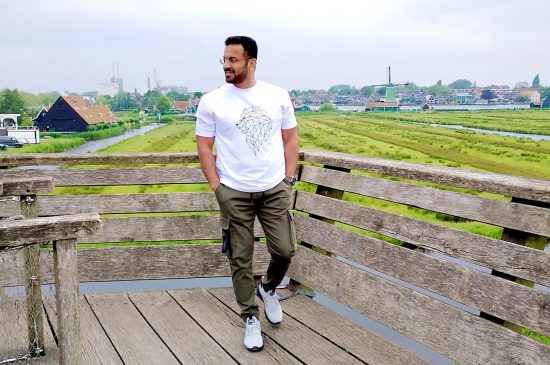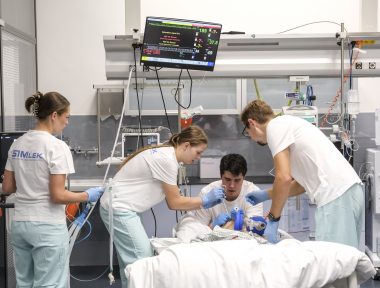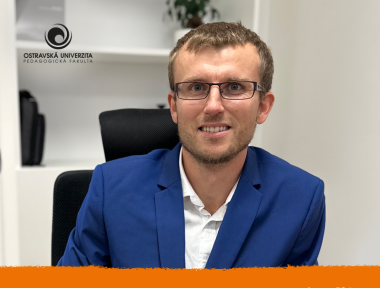From satellite mapping to hands-on projects in Ostrava, Dr. Salman Qureshi advocates for sustainability not as a luxury or abstract goal, but as a practical mindset rooted in collaboration and personal accountability, and long-term vision. The University of Ostrava welcomed the renowned scientist Dr. Salman Qureshi, who joined the Department of Social Geography and Regional Development at the Faculty of Science through the Global Experts Program.

This article is also available in Czech: „Musíme vychovat generaci s pocitem zodpovědnosti,“ říká globální expert Salman Qureshi
Také čtěte
What inspired you to explore sustainable urban development?
My interest in sustainability science and urban ecosystems was first sparked during my postgraduate research, where I employed satellite remote sensing and digital mapping technologies to analyze urban environments. These tools offered a comprehensive a “bird’s-eye view” that revealed spatial patterns and dynamics of cities often obscured at ground level. This perspective enabled me to critically assess the structural and ecological complexities of urban landscapes in ways that conventional field methods could not.
What stood out to me was the prevailing narrative that positioned cities as inherently problematic, frequently depicted in contrast to an idealized, untouched nature. Nature was celebrated as pure and harmonious, while urban environments were framed as artificial, degraded, or even “anti-nature.” I observed that much of the existing urban sustainability research treated cities as separate from ecological systems, focusing primarily on environmental indicators such as air quality, pollution, or biodiversity, while often neglecting the role of human communities as active, integral components of these ecosystems.
This realization led me to a critical question: how can we reimagine cities not as ecological liabilities, but as potential sites of sustainability and resilience? It motivated me to pursue an interdisciplinary research agenda that bridges ecological science with social inquiry while integrating human behavior, cultural values, and urban systems into a more inclusive understanding of sustainability.
What stood out to me was the prevailing narrative that positioned cities as inherently problematic, frequently depicted in contrast to an idealized, untouched nature.
What current project are you most deeply involved in at this time?
I am currently engaged in a range of major initiatives, one of which is the Global Expert Program. Within this framework, I am actively developing and expanding my research program and establishing a dedicated laboratory focused on sustainability science. A flagship project centers on the role of green spaces in Ostrava and the broader Moravian-Silesian region. This initiative adopts a multidisciplinary lens, not limited to spatial planning, but encompassing how individuals perceive, interact with, and derive well-being from these urban green environments. The ultimate objective extends beyond infrastructural enhancement to fostering holistic human and ecological well-being.
An integral component of this work involves the incorporation of key environmental parameters, including air quality, solid waste management, and soil contamination. The central challenge lies in synthesizing these diverse disciplinary insights into a coherent and accessible framework for policymakers. To this end, the project emphasizes data visualization and integrative mapping tools, aiming to convey biological, social, and environmental dimensions in a unified, intuitive format. This approach also highlights the potential for community engagement and citizen science to emerge from interdisciplinary collaboration.
Managing such a complex and ambitious undertaking demands considerable time and coordination. It involves close collaboration with professionals across a wide spectrum including biologists, sociologists, medical experts, urban planners, architects, and policy-makers. I find great fulfillment in facilitating these cross-sectoral partnerships, creating collaborative platforms that unite diverse stakeholders in pursuit of shared solutions.
The Global Experts program aims to attract top scientists who have been working abroad for a long time to local universities. It provides researchers with attractive conditions for their work, contributing to the quality and relevance of research at these universities. As a result, new research teams are being formed, which also opens up new opportunities for the professional growth of young scientists.
How do you define your role or perspective within the field of sustainable urban research?
I identify as an urban ecologist with a primary focus on the intricate dynamics of socio-ecological systems. These systems intersect two traditionally distinct domains. One is the social sphere, commonly examined through sociology, and related disciplines and the ecological dimension of urban environments, explored through ecology, biology, zoology, and botany. The central challenge in this field arises from the need to integrate these perspectives into a cohesive analytical framework, a task that defines the essence of socio-ecological research.
Bridging the divide between the social sciences and ecological sciences is inherently complex. Social sciences grapple with human behavior, cultural norms, and institutional structures, while ecological sciences investigate biophysical processes and environmental patterns. Integrating these paradigms necessitates the development of innovative, transdisciplinary methodologies capable of capturing the feedback loops and interdependencies within urban systems. My work operates within this intellectual interstice, seeking to synthesize social and environmental knowledge to address urban sustainability challenges.
In pursuit of this goal, I have collaborated extensively with environmental psychologists, public health professionals, and other specialists to explore how individuals perceive, interact with, and are affected by their surrounding environments. This interdisciplinary engagement is not only methodologically enriching but also essential for generating actionable insights into the human-environment interface in urban contexts.
Why did you choose Ostrava for your research?
Before I came here I had never heard about Ostrava. I actually came across the project REFRESH, and while I was exploring some of the ongoing activities, I stumbled upon it and thought that this was a really interesting and important project. I looked into the profiles of the people involved — Ondrej Slach, Peter Rumpel, and others and I immediately felt that this is something big and meaningful what I would like to be a part of.
Dr. Salman Qureshi’s research explores how urban environments can function more sustainably by identifying, valuing, and protecting the ecological services provided by urban ecosystems—such as climate regulation, air purification, and human well-being. His work combines ecological modeling with social and political analysis to better understand the multifaceted impacts of climate change on cities. By situating environmental issues within their broader socio-political contexts, Dr. Qureshi offers a holistic perspective on the complex relationships between people and their environments. His interdisciplinary approach contributes to advancing sustainable urban development in response to global environmental challenges.
Is there something that surprised you in Ostrava?
One of the most striking impressions I formed upon arriving was the warmth and friendliness of the local community. Contrary to common perceptions that the Czech Republic may be somewhat reserved toward foreigners, my experience has been profoundly positive. I have been genuinely impressed by the openness and willingness of people to engage, even in everyday encounters—whether in the streets, markets, or restaurants. Despite language barriers, individuals consistently go out of their way to offer assistance, reflecting a deep sense of civility and hospitality.
This welcoming atmosphere was particularly unexpected given the reservations expressed by my family, who were apprehensive about my relocation, especially considering my background in more culturally diverse environments such as the United Kingdom. Yet, what I have encountered here has far exceeded those expectations, revealing a society that, while perhaps understated in its openness, is nonetheless deeply generous in its human interactions.
I have been genuinely impressed by the openness and willingness of people to engage, even in everyday encounters—whether in the streets, markets, or restaurants. Despite language barriers, individuals consistently go out of their way to offer assistance, reflecting a deep sense of civility and hospitality.
Is there a city you think has been particularly successful in implementing sustainable approaches? And are there any cities that Ostrava could learn from, or perhaps cities that could learn from Ostrava’s experiences?
Many cities have successful sustainability initiatives, like Copenhagen, Amsterdam, Rotterdam, and Barcelona. Barcelona, for example, has made strides with bike lanes and reducing traffic, which works well in large cities. While Ostrava doesn’t face the same challenges, there are still lessons to be learned.
What Ostrava can teach other cities is how universities can collaborate with decision-makers. The partnership between MAPPA, a city-financed private company, and the local university is a great example. Ostrava can also serve as a model for public-private-academic partnerships. The city’s younger generation, in their 30s and 40s, is particularly driven to make a difference, which is a major strength. The Moravian-Silesian Innovation Center has been impressive, and I’m excited to be working on collaborative projects here. Overall, Ostrava is on the right path, and the energy from younger leaders is one of the key reasons I chose to come here.
But what about ordinary people? What can a regular citizen actually do to help us live in a sustainable city?
The foundation of sustainability lies in truly understanding its essence. At its core, sustainability is the practice of utilizing resources such as forests, fossil fuels, food, water, or urban land without depleting them, ensuring their availability for future generations. It is fundamentally about curbing overconsumption and managing human needs within ecological limits.
On an individual level, sustainability manifests through everyday, intentional choices such as purchasing only what is necessary, minimizing waste, using public transportation, and caring for shared public spaces. Countries such as Austria, Germany, and Japan exemplify how these practices can be embedded into daily life. In Japan, for instance, it is common for individuals to take their waste home rather than rely on public bins, demonstrating a culturally ingrained ethic of personal responsibility.
Cultivating such responsibility among citizens is, in many ways, sufficient. We do not need every individual to become an environmental expert; rather, we need a populace that is conscious, considerate, and informed. Unfortunately, sustainability discourse is often abstract and inaccessible particularly for younger generations. To be effective, education around sustainability must be experiential, engaging, and collaborative.
This philosophy aligns with the ideas at Moravian-Silesian Innovation Center, where the emphasis is not on instructing youth, but on empowering them to become change agents. Transforming a city is not an overnight endeavor; it demands a generational shift in values and behavior. Countries like Japan and China offer instructive examples where change emerges gradually through cultural evolution and education. Our task is to plant the seeds of responsibility today so that a more sustainable future can take root tomorrow.
On an individual level, sustainability manifests through everyday, intentional choices such as purchasing only what is necessary, minimizing waste, using public transportation, and caring for shared public spaces.
From your perspective, what are some of the biggest impacts of climate change on cities today? And what can we do to address them?
One major impact of climate change on cities is the Urban Heat Island effect. It’s most visible in dense cities like Paris, Berlin, and New York, where concrete and asphalt trap heat, making urban areas much hotter than the countryside. In smaller cities like Ostrava, this effect is less pronounced due to lower population density.
To combat this, many cities invest in green infrastructure. Singapore, Copenhagen, and the Netherlands use green roofs, vertical gardens, and urban green spaces to cool down their environments. Berlin even requires developers to offset large concrete structures with green spaces, making it one of Europe’s greenest cities despite its 3.8 million residents.
Another key strategy is blue-green infrastructure, which combines parks with water systems like rivers and canals. Cities like Barcelona are redesigning public spaces with this in mind, creating cooler, healthier environments. The challenge is balance. Cities will keep growing, but development must align with nature-based solutions. It’s not about stopping progress, it’s about building smarter, greener, and more sustainable cities.
Do you have a vision of the ideal sustainable city of the future?
While sustainability is often discussed in abstract terms, a more fundamental question remains: what truly makes a place livable, with human well-being at its core? Consider the case of the United Arab Emirates. Despite massive investments in high-profile sustainable urban developments, such as NEOM in Saudi Arabia (a planned smart city promising futuristic innovation) these visions often remain aspirational rather than lived realities. In cities like Dubai, luxurious living conditions are accessible to a privileged few, while many migrant workers endure difficult and inequitable circumstances. In contrast, Scandinavian cities consistently rank high on global Happiness Indices, largely because they emphasize inclusivity, equity, and well-being for all citizens.
Public discourse frequently equates sustainability with technological efficiency including smart infrastructure, waste reduction, and fossil fuel elimination. While these elements are undeniably important, they do not alone guarantee quality of life. People do not relocate or settle in a city solely for its carbon-neutral footprint, they do so in pursuit of a meaningful, fulfilling life.
In my own case, I chose Ostrava not only for its professional opportunities, but for what I refer to as academic happiness: a sense of intellectual fulfillment and community engagement. Others may find their well-being in creative pursuits, entrepreneurial ventures, or a quiet family life. Ultimately, sustainable cities must be more than environmentally efficient; they must be places where diverse forms of human flourishing are actively supported.


 10 min.
10 min. 



